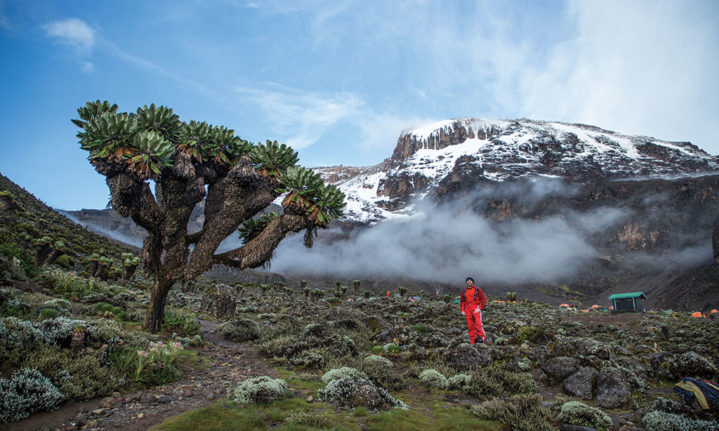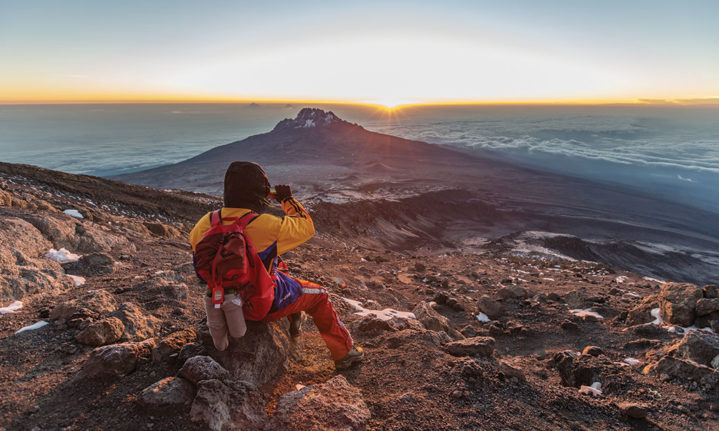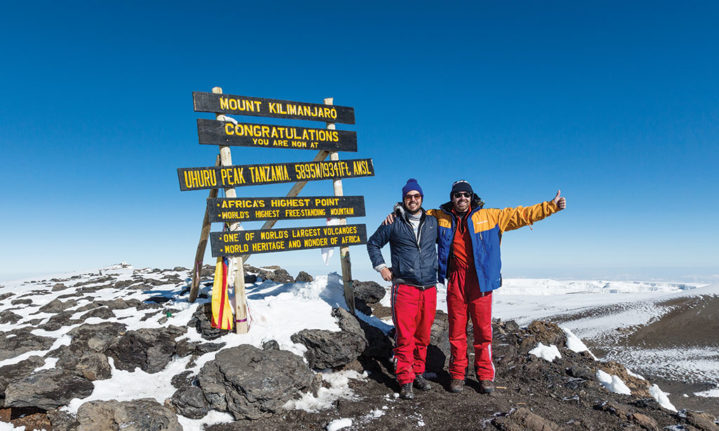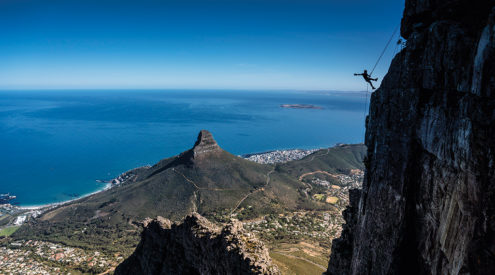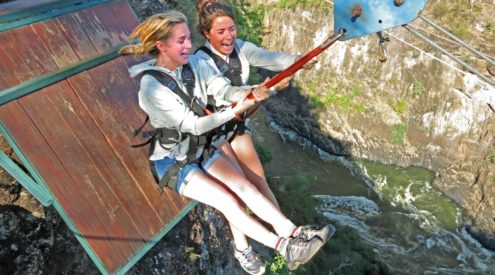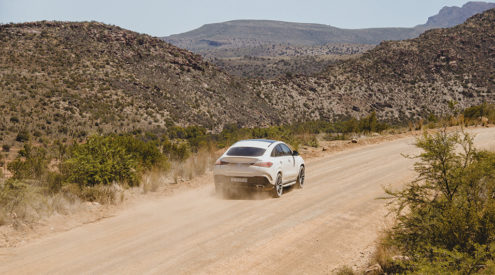Mike Tyson once said, ‘Everybody has a plan until they get punched in the mouth.’ The man with the world’s most famous face tattoo was referring to boxing, but his quote also sums up my summit attempt of Kilimanjaro.
You see, I had a pretty good strategy laid out for climbing it, but once the mountain had me in its oxygen-depleted grip, the plan was quickly forgotten – along with my ability to think or walk straight.
Our summit started well enough. We awoke in base camp at midnight and, after a personal pep talk, I dressed in all the clothes I had, topped off with gloves, balaclava and beanie. Temperatures can drop to -25°C so there’s no messing around up there.
I stepped out of my tent to find us suspended in a galaxy of contrasting light sources. An almost-full moon and stars cast a bright light on our campsite, while four kilometres below the tiny lights of Moshi twinkled softly. Far in the distance, a thunderstorm was in full flex, shooting off as frantically as red-carpet paparazzi. And the ground, covered in ice particles, sparkled like the stars above.
I found the only other hiker in my group in the mess tent. A former university athletics star from Washington DC, he had an eerily similar name to my own: Benjamin Matthew Stern. Sharing meals and stories for six days, we had little choice but to become fast friends on the mountain.
‘We’re just seven hours from African glory,’ I reminded him, and then sat down gasping after packing my bag too quickly. The mountain has a way of keeping egos in check. We set off with two guides and two porters in tow. Overly confident, I was unaware of the emotional and physical beating I was about to endure.

After a lunch stop at Lava Tower (4 600 metres), hikers descend 600 metres to the Barranco Camp where giant groundsel trees dot the landscape. Image: Matthew Sterne.
Kilimanjaro is the most popular of the world’s seven summits (the highest mountain on each continent) primarily because it’s the most attainable. You don’t need ropes, special gear or even any previous mountaineering experience. This does not mean, however, that it’s easy or risk-free. Rockslides and acute mountain sickness cause fatalities every year, and helicopter rescues are common.
Up close, Kilimanjaro was even more impressive than I expected. Upon seeing it, I immediately understood why this snow-topped mountain on the Equator is considered one of the world’s great natural wonders.
Its base is an island of green forest in an ocean of dry savannah, which rises up to three volcanic craters and a collection of famous glaciers. Home to unique flora such as giant lobelias and groundsels, Kilimanjaro has captured the imagination of mountain lovers around the world. ‘There’s a romance to it,’ Ben said. ‘In a land of giants, Kilimanjaro is the king.’
We started our hike, the six-day Machame Route, in a rainforest at 1, 800 metres. Over the course of the first three days, the vegetation changed from trees to head-high bushes to shrubs to rocks to the nothingness of an alpine desert.
Climbing Kilimanjaro, they say, is like walking from the Equator to the North Pole in a week. Occasionally, we were granted stride-breaking views of Mount Meru, Tanzania’s second-tallest mountain.
We followed the deliberate pace of our guide, John Matiko, a stoic former businessman who has climbed Kilimanjaro more than 200 times. His advice was simple: drink four litres of water a day, stay positive, take Diamox for the altitude, and always remember the Kilimanjaro mantra of walking ‘pole pole’ (Swahili for ‘slowly, slowly’).
I was reminded of the teachings of the Zen masters who advised people to ‘smile, breathe and go slowly’. Our pace was so even, it did feel like meditation at times.
Staying positive would turn out to be crucial. Take day three, for example. We started walking in clouds and drizzle, which became heavy rain and then hail. The trail turned into a river and we made it to camp seven hours later, drenched and shivering. John chuckled. ‘This is not normal for the dry season.’
Close to dusk, the clouds lifted, granting us a glimpse of the snowy peak of the Barranco Wall,
400 metres above us, a reminder of the grand scale of our adventure and a boost to our morale. Ben and I went on a walk around our campsite and found other hikers standing outside their tents looking shell-shocked after the day’s struggle, taking stock of what had been lost and what remained.
We stared down the gorge and across the plains beyond. Smaller mountains rippled away from us like waves in the ocean. These endless views would prove to be one of the major charms of climbing the world’s tallest freestanding mountain.
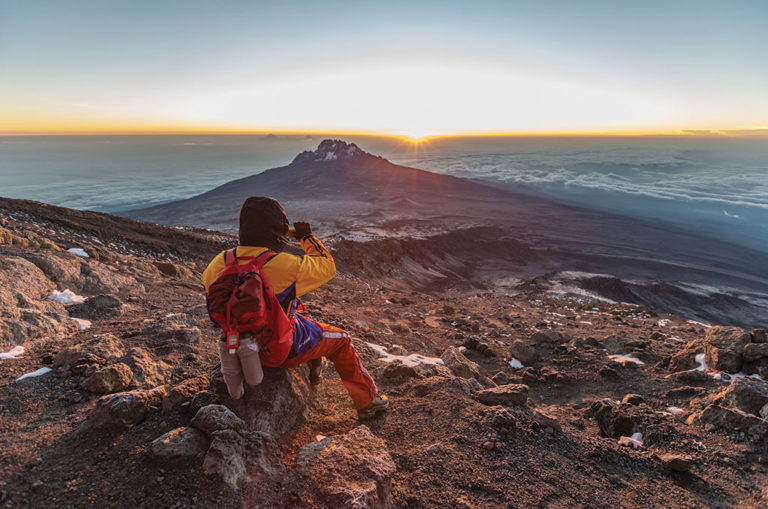
Looking out over Mawenzi, one of Kilimanjaro’s three volcanic cones. Image: Matthew Sterne.
Four hours into our summit bid, all I could hear was the crunch of our shoes on the rocky trail, the pfft-pfft of our waterproof pants, and my laboured breathing. Dizziness came first, then blurred vision, a headache and a mind unable to finish a thought.
We paused every half hour and I’d slump down against a rock while the guides tended to me like a wounded fighter between rounds, adjusting my clothing and giving me water as I sat in a stupor.
I slipped into semi-consciousness where mild hallucinations haunted the corners of my vision. I could feel my heartbeat in my throat. My world narrowed. We kept going. Head down. Feet forward. Just take it … breathe … one step at a time … breathe.
While tackling Kilimanjaro is tough for modern climbers, it was near impossible for the original mountaineers. The first man to the top, Hans Meyer, needed three expeditions to succeed. The German geology professor was initially thwarted by 40-metre ice walls, and the following year was captured and ransomed during the Abushiri Revolt. In 1889, Meyer finally summited, discovering the secret of the massive, ice-covered crater on top. It would not be climbed for another 20 years.
The mountain looks somewhat different now. It’s lost 80 per cent of its ice over the last 100 years and predictions estimate it’ll only last from as little as 10 to 30 years. Whatever the case, the ice is visibly shrinking every year. Go before it’s too late.
The good news is that the litter and dirty camps that once marred Kilimanjaro’s reputation have been dealt with by the Tanzania National Parks Authority. I saw almost no litter. And crowds? Yes, it was busy, especially with nearly five porters for every hiker, but we only had one ‘traffic jam’, when the trail snaked through a narrow rock formation.
Instead of them being a nuisance, I found the other hikers a source of motivation. There’s banter and a sense of camaraderie. In the mornings, as camp is broken, you become part of a travelling caravan, united by a shared quest.
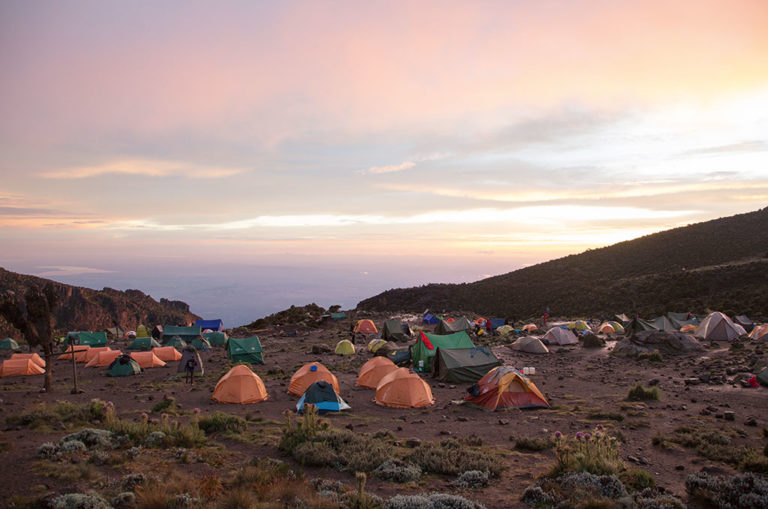
General camp rule: round tents are for sleeping, rectangular for eating. This is Barranco Camp on day three. Image: Matthew Sterne.
The apricot glow of sunrise came and went above a duvet of white clouds. I dimly thought that heavenly scenes like this might be why locals believe the mountain is the seat of God. An hour later we reached Stella Point, our appointed spot for a revitalising cup of ginger tea. After finding some shade, I collapsed like a pile of sticks, dumb and numb.
Ben, on the other hand, seemed as chipper as ever, and chatted to everyone we encountered like he was out for a Saturday stroll. He may have the same name, but I confess to cursing him at those moments. That’s the thing about altitude, it affects everyone differently and you don’t really know how you’ll fare until you’re up there. Maybe that’s part of the allure of Kilimanjaro’s challenge? Just battle on and find a way to stay in it.
We forged on and were soon peering down into the snow-covered, outer crater of Kibo. After cresting a hill, we saw Rebmann Glacier, a small remnant of an enormous ice cap that once crowned the summit. We were, at last, into the snows of Kilimanjaro, and enjoying one of the grandest views in Africa.
The summit appeared a hundred metres in front of us. The sun was well out at this point and icy Uhuru Peak rose above the clouds like a massive igloo on a misty lake. We drifted towards the top, taking our time, savouring our arrival.
We had done it. For a moment we stood atop it all, elated, exhausted and proud – the highest people in Africa.
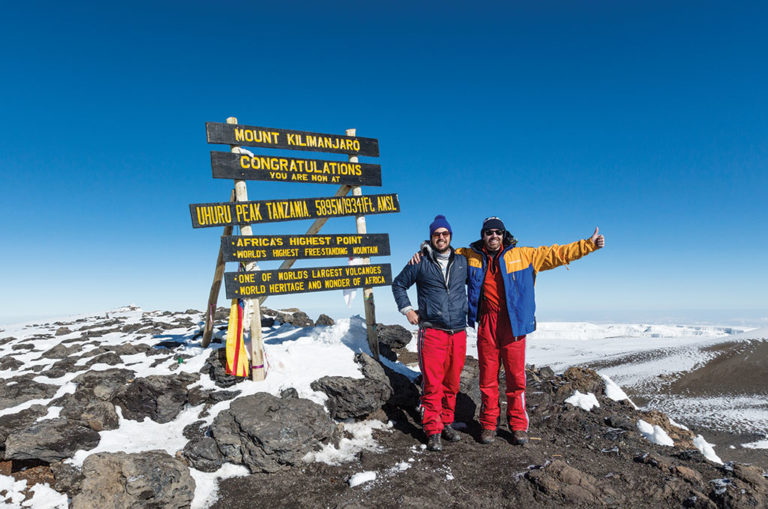
Sterne and Stern on top of Africa! Image: Matthew Sterne.
Do this
Climbing Kilimanjaro has had more than 15,000 successful summits since 1994. The guides were intent on our success and tested our oxygen levels and pulse twice a day; food was plentiful. Trips depart daily, and cost from R19 500 to R36 000, depending on your route and number of days (I took six days). They also offer mountain biking to the summit. climbingkilimanjaro.co.za
Words and images: Matthew Sterne









